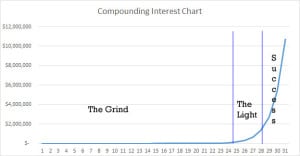I Gave my Kids $200,000 for Christmas: Do You Want to Learn the Secret?
Last year, I wrote about how I gave my daughter $50,000 for Christmas. Of course, I had to top that gift this year, because “obviously” that’s how Christmas works (not really). This year’s post is going to talk about Roth IRA’s again for kids, continuing with new and improved ideas from last year.
I know what you’re thinking: I can barely afford $2,000 for kids gifts, let alone $200,000! How is this even possible?
Before we discuss affording gifts, let’s talk about the mindsets tied to giving and receiving gifts at Christmas. This isn’t a competition. You shouldn’t be competing with other people to see who gives the best and most extravagant gifts, but you also shouldn’t feel like you constantly have to top what you did last year. When you stop competing, you get to have what you want.
Something else to think about: Do you still remember all the things you bought last year and continue to enjoy them? Hopefully you aren’t still paying the bills from last Christmas (please don’t go into debt this Christmas). If you are going to spend all your money on stuff you don’t care about, you are handing over your hard earned dollars to make someone else’s dreams possible. Stop! (You actually can)
Instead, let’s build a future for your kids. Giving your kids $200,000 for Christmas is not as hard as you may think. However, the lessons you are going to teach them are more important than the money.
- Delayed gratification – this concept is simple; it’s the patience to wait for something. Surely after years of dealing with kids, you wish they had more patience! If you have never heard of the correlation between delayed gratification and success in life, check out the story of cute 4 year olds and 1 or 2 marshmallows https://www.youtube.com/
- Compound interest –“Compound interest is the eighth wonder of the world. He who understands it, earns it … he who doesn’t … pays it.”― Albert Einstein. I have already written a post on compound interest. Find it here: Compound Interest post Compound interest is the principle that will allow you to give your child $100,000 this Christmas; we’ll talk about this in a moment (See? I’m teaching you delayed gratification!).

- The power of saving – Saving small amounts over time will eventually grow into a large amount of money (If you read my post on compounding you will know the power of the penny! Compound Interest post). By learning principle one and applying principle two and seeing the result of $100,000 over time, you teach how the power of saving small amounts can turn into large savings. On the flip side, borrowing (for stuff you can’t even remember) creates a large load of oppressive debt that only continues to grow larger.
So let’s get to the specifics. The first step is understanding the tax code and how to use it to your advantage. There are no minimum age limits on opening a Roth IRA, a special account that allows your money to grow tax-free even when you withdraw from the account at retirement. There are also ways to withdraw money before age 65, tax-free. Many companies may not allow you to open an account, but I was able to open one at Vanguard for my kids. In order to open a Roth IRA, you need to have earned income. This means that your child has to work, and it’s okay if they work for you (think babysitting and mowing lawns). My kids each earned over $2,000 this past year helping me with a variety of jobs. When you invest that $2,000 in a Roth IRA, it grows tax free and will never be taxed again under the current rules. With 50 years until retirement (15 – 65) the money will grow and compound to over 100,000 if you earn an 8% rate of return.
Now imagine that we do this every year from now through college! For my daughter who started with $1,000 last year, she could graduate college with a $750,000 retirement plan already funded. To me, that seems a lot more valuable than the college degree (that’s a topic for another time, and I can assure you I won’t be spending on it for my kids). If you can increase the amounts invested, the results can be far greater. You are allowed up to $5,500 per year in contributions, but this may be limited if you are high income earner.
If you contributed the maximum amount for 5 years, you would have $300,000 per year for a total of $1,500,000. Imagine graduating college and knowing you will be a millionaire because of your retirement plan; sure beats carrying a load of student debt!
Make this a really Merry Christmas and set your kids up for success!
If you are interested in hearing more, my daughter and I chat about this and more. Check it out: https://richersoul.com/ep-0072-intentionally-raising-financially-savvy-kids-with-my-daughter-geeta/
Disclaimer! – You’re a special and unique snowflake and I don’t know you or your financial situation, so you should check with your tax and investment professional before you follow advice on the internet or anything posted be me.








This is super smart. I am calling my CPA, today on how to report income for my kiddo who is in elementary school. Thanks, Rocky!
Glad I could help. It’s sometimes hard with younger kids to get earned income. However if you own a business it’s easier.
I totally agree that investing for your children is a great gift and potentially more valuable than college. I went to a private college, my husband went to a state university, and my daughter went to a city college. The difference in cost from private to city was $200k! That’s enough to buy a house for cash in many parts. For now, we’re funding Roth IRA’s for her, as that makes the most sense given her situation.
Rocky,
I’m glad I stumbled on this post from a Facebook feed. My daughter is 16 and we have been contributing to an UTMA aggressively for the last year or so. She recently got her first W-2 job and we are in the process of starting her Vanguard Roth. (Have to fill out a paper copy and mail it in – can’t do it online). She plans to put every penny she earns into VTSAX. She probably doesn’t understand all of the reasons this makes sense but she is getting into the habit of placing her hard earned cash somewhere else than at the mall’s cashiers. Time will tell how it all turns out. Thank you for making this post and championing the idea of helping our children get off to a better start, and understanding, when it comes to the importance of designing a financial future. And I look forward to our next visit.
Congrats David on raising a money-savvy kid! I think our kids will be singing our praises in about 30 years when that money has seen a few doubles and they have total freedom in life!